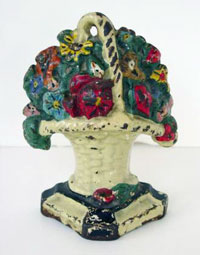|
Cast Iron Doorstops
 Cast iron doorstops are prized as folk art as well as by doorstop collectors. Doorstops (originally called door porters) were first produced in Europe in the late 1700s to hold open doors for air circulation and to ensure the door would not slam shut. By the mid 1800s, in Europe, doorstops became a fashionable decorative item and more widely manufactured. After the Civil War, their popularity and manufacture migrated to the United States where they were smaller in size and weight in comparison to their European counterparts. Cast iron doorstops are prized as folk art as well as by doorstop collectors. Doorstops (originally called door porters) were first produced in Europe in the late 1700s to hold open doors for air circulation and to ensure the door would not slam shut. By the mid 1800s, in Europe, doorstops became a fashionable decorative item and more widely manufactured. After the Civil War, their popularity and manufacture migrated to the United States where they were smaller in size and weight in comparison to their European counterparts.
Flower baskets, cottages, animals and people were the most common doorstop shapes produced. More than 1,000 American-made doorstops are known, and there are at least 35 different doorstops that look like Boston terriers. American manufacturers included the Albany Foundry Co., in Albany, NY; the Hubley Manufacturing Co., in Lancaster, PA; and Bradley & Hubbard, in Meriden, CT. Production of doorstops was curtailed during World War II and most foundries never recovered and were closed in the late 1940s and early 1950s.
Doorstops were created by first carving out a three-dimensional form from wood, or by hammering the doorstop design out in metal. The form was then pressed into fine, compacted sand making an impression. Molten iron, heated to 3,000 degrees, was poured into the sand mold. When cooled, the form would pop out. Rough edges were filed off, a ground coat of paint added, and then painted according to the desired motif.
A well-cast older doorstop will be smooth in texture with a refined casting. Seams in the casting, if any, should be uniform and not more than 1/16 inch gap. The pieces should meet properly and not be offset from one another. Any screws should be a slotted flat head. Phillips-head screws indicate a reproduction. The mold marks in old casting were generally ground off by hand using a file, while reproductions are cleaned up using power tools and tumblers, leaving coarser grinding marks. Look carefully at the wear patterns on the doorstop, and remember most old doorstops were used for their original purpose of holding doors open. Therefore, look for wear in the logical places - at the top where it was handled and around the base. A Hubley doorstop will have a three-digit number incised into the metal.
There are three main factors used to evaluate a doorstop: condition, desirability, and rarity. A piece with all three of these will bring the highest price in the marketplace.
Doorstops are collected for different reasons – beauty, nostalgia, or aesthetic appreciation. Others collect by theme such as cats, dogs, birds, flowers, wildlife, black memorabilia, sports, comic images and nautical. Some collectors collect only pieces made by a particular foundry, and still others collect from a combination of all of these motivations and more.
Search for doorstops on Dig Antiques.
References:
- Collecting Doorstops, John C. & Nancy M. Smith, The Journal of Antiques and Collectibles, August 2006.
- Cast iron doorstops are top sellers, ctpost.com, May 3, 2012.
- Determining the Authenticity of Antique Doorstops, doorstops.com.
- Antiques: Cast-Iron Doorstops, Yankee Magazine, November 2006.
- Hubley Doorstops & Toys Information & History, Collectics.com.
- How to Know a Hubley Doorstop Is Real, Meredith Jamescon, eHow.
- Old Figural Cast-Iron Doorstops Affordable and Available, The Antique Detective, Anne Gilbert.
|
|
Easy Inventory Maintenance on the Shops at Dig Antiques
At the VADA Antiques Show this past weekend, I was walking around showing dealers how easy it is to add items and update a Dig Antiques Shop. It was the first time we had our iPad at a show where wireless was available.
I was able to quickly add items that a dealer had on the show floor on Dig Antiques. It was simple - just fill in a form with the title, description, price. For the photo, you just click the "Choose File" and either choose an existing photo or if you are on an iPad (or other tablets with integrated camera), you can take a picture right from there.
Tom added two new items to his Baker & Co. Antiques Shop (the top two - red gloves and oval pantry box) while in his booth at the show. It was fast and easy!
What's keeping you from opening a Shop on Dig Antiques? At $149/year for ten items (photo & description) that you can update at any time you want to is really inexpensive. We invite you to open your own Shop and join us!
Picker's Market Antiques Show
Please stop by and visit with us at the Picker's Market Antiques Show on Friday, August 9 from 10am-5pm. Stop in and see us and pick up your Dig Antiques reusable shopping tote! And, talk with us about opening your own Dig Antiques Shop.
Sincerely,
Tom & Sheila Baker
diginfo@digantiques.com
We Dig It...do you? Dig Antiques - Real stuff without the fluff.
 
|

 Cast iron
Cast iron